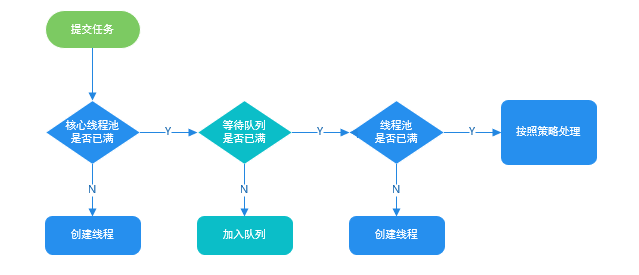# ThreadPoolExecutor 线程池 👍
# 参数说明
ThreadPoolExecutor 提供了四个构造方法
这里以最后一个构造方法(参数最多的那个),对其参数进行解释:
/**
* Creates a new {@code ThreadPoolExecutor} with the given initial
* parameters.
*
* @param corePoolSize the number of threads to keep in the pool, even
* if they are idle, unless {@code allowCoreThreadTimeOut} is set
* @param maximumPoolSize the maximum number of threads to allow in the
* pool
* @param keepAliveTime when the number of threads is greater than
* the core, this is the maximum time that excess idle threads
* will wait for new tasks before terminating.
* @param unit the time unit for the {@code keepAliveTime} argument
* @param workQueue the queue to use for holding tasks before they are
* executed. This queue will hold only the {@code Runnable}
* tasks submitted by the {@code execute} method.
* @param threadFactory the factory to use when the executor
* creates a new thread
* @param handler the handler to use when execution is blocked
* because the thread bounds and queue capacities are reached
* @throws IllegalArgumentException if one of the following holds:<br>
* {@code corePoolSize < 0}<br>
* {@code keepAliveTime < 0}<br>
* {@code maximumPoolSize <= 0}<br>
* {@code maximumPoolSize < corePoolSize}
* @throws NullPointerException if {@code workQueue}
* or {@code threadFactory} or {@code handler} is null
*/
public ThreadPoolExecutor(int corePoolSize,
int maximumPoolSize,
long keepAliveTime,
TimeUnit unit,
BlockingQueue<Runnable> workQueue,
ThreadFactory threadFactory,
RejectedExecutionHandler handler) {
if (corePoolSize < 0 ||
maximumPoolSize <= 0 ||
maximumPoolSize < corePoolSize ||
keepAliveTime < 0)
throw new IllegalArgumentException();
if (workQueue == null || threadFactory == null || handler == null)
throw new NullPointerException();
this.acc = System.getSecurityManager() == null ?
null :
AccessController.getContext();
this.corePoolSize = corePoolSize;
this.maximumPoolSize = maximumPoolSize;
this.workQueue = workQueue;
this.keepAliveTime = unit.toNanos(keepAliveTime);
this.threadFactory = threadFactory;
this.handler = handler;
}
2
3
4
5
6
7
8
9
10
11
12
13
14
15
16
17
18
19
20
21
22
23
24
25
26
27
28
29
30
31
32
33
34
35
36
37
38
39
40
41
42
43
44
45
46
47
48
49
50
51
| 序号 | 属性 | 类型 | 含义 |
|---|---|---|---|
| 1 | corePoolSize | int | 核心线程数线程数定义了最小可以同时运行的线程数量。 |
| 2 | maximumPoolSize | int | 线程池中允许的最大线程数,线程池中的当前线程数目不会超过该值。 |
| 3 | workQueue | BlockingQueue | 当新任务来的时候会先判断当前运行的线程数量是否达到核心线程数,如果达到的话,新任务就会被存放在队列中。 |
| 4 | keepAliveTime | long | 当线程池中的线程数量大于 corePoolSize 的时候,如果这时没有新的任务提交,核心线程外的线程不会立即销毁,而是会等待,直到等待的时间超过了keepAliveTime才会被回收销毁; |
| 5 | unit | TimeUnit | keepAliveTime 参数的时间单位。 |
| 6 | threadFactory | int | executor 创建新线程的时候会用到。 |
| 7 | handler | int | 饱和策略。 |
handler的饱和(拒绝)策略
AbortPolicy: 不执行新任务,直接抛出异常,提示线程池已满DisCardPolicy: 不执行新任务,也不抛出异常DisCardOldSetPolicy: 将消息队列中的第一个任务替换为当前新进来的任务执行CallerRunsPolicy: 直接调用execute来执行当前任务
# 实现原理

线程池中任务是按照提交的顺序执行的吗?
- 根据线程池的实现原理,是不会的;
- 当核心线程池已满并且等待队列已满后,会根据
maximumPoolSize来创建创建线程,此时后提交的线程的执行顺序就在等待队列中的线程之前;
# keepAliveTime 的作用
- 非核心线程在空闲状态下,超过
keepAliveTime时间,就会被回收; - 如果核心线程设置了
allowCoreThreadTimeOut(true)的话(默认设置false),那么在空闲时,超过keepAliveTime时间,也会被回收;
线程池核心线程是否会被回收?
- 默认情况下不会,线程池只能回收非核心线程;
- 如果核心线程设置了
allowCoreThreadTimeOut(true),那么在空闲时,超过keepAliveTime时间,会被回收; - 一般情况下,不需要回收核心线程,因为线程池本身就是实现线程的复用,而且,这些核心线程在没有处理任务时,处于阻塞状态,并没有占用CPU资源;
# 线程是如何根据 keepAliveTime 进行销毁的
// ThreadPoolExecutor.java
final void runWorker(Worker w) {
try {
while (task != null || (task = getTask()) != null){
}
} finally {
processWorkerExit(w, completedAbruptly);
}
}
2
3
4
5
6
7
8
9
10
线程池是通过runWorker()这个方法进行自旋,从队列中获取任务执行,对keepAliveTime的使用,就在getTask()方法中。
private Runnable getTask() {
boolean timedOut = false; // Did the last poll() time out?
for (;;) {
int c = ctl.get();
int rs = runStateOf(c);
// Check if queue empty only if necessary.
if (rs >= SHUTDOWN && (rs >= STOP || workQueue.isEmpty())) {
decrementWorkerCount();
return null;
}
int wc = workerCountOf(c);
// Are workers subject to culling?
boolean timed = allowCoreThreadTimeOut || wc > corePoolSize;
if ((wc > maximumPoolSize || (timed && timedOut))
&& (wc > 1 || workQueue.isEmpty())) {
if (compareAndDecrementWorkerCount(c))
return null;
continue;
}
try {
Runnable r = timed ?
workQueue.poll(keepAliveTime, TimeUnit.NANOSECONDS) :
workQueue.take();
if (r != null)
return r;
timedOut = true;
} catch (InterruptedException retry) {
timedOut = false;
}
}
}
2
3
4
5
6
7
8
9
10
11
12
13
14
15
16
17
18
19
20
21
22
23
24
25
26
27
28
29
30
31
32
33
34
35
36
37
- 进入自旋,当
allowCoreThreadTimeOut为true或者当前任务数超过核心线程数时,设置timed为true,表示需要进行超时判断。 - 如果timed为true说明worker有可能要被关闭,那么通过workQueue.poll取任务,如果超过
keepAliveTime纳秒还没取到任务,就返回null,后面会调用processWorkerExit把worker关闭;
# workQueue
用于保存等待执行任务的阻塞队列
- ArrayBlockingQueue:是一个基于数组结构的有界阻塞队列,此队列按 FIFO(先进先出)原则对元素进行排序。
- LinkedBlockingQueue:一个基于链表结构的阻塞队列,此队列按FIFO (先进先出) 排序元素,吞吐量通常要高于
ArrayBlockingQueue。静态工厂方法Executors.newFixedThreadPool()使用了这个队列 - SynchronousQueue:一个不存储元素的阻塞队列。每个插入操作必须等到另一个线程调用移除操作,否则插入操作一直处于阻塞状态,吞吐量通常要高于
LinkedBlockingQueue,静态工厂方法Executors.newCachedThreadPool使用了这个队列。 - PriorityBlockingQueue:一个具有优先级的无限阻塞队列。
# execute() & submit() 的区别
没有引用线程池的时候,需要我们通过继承Thread类和实现Runnable、Callable接口,最终调用start()方法启动线程
在线程池中,提交线程的方法有以下两种,源码如下:
// ExecutorService.java 接口
<T> Future<T> submit(Callable<T> task);
<T> Future<T> submit(Runnable task, T result);
2
3
4
// Executor.java 接口
void execute(Runnable command);
2
- submit() 可以提交 Runnable 类型的任务、Callable 类型的任务 ,execute() 可以提交 Runnable 类型的任务
- submit() 有返回值,execute() 没有返回值
# 实现 Runnable 接口和 Callable 接口的区别
Runnable自 Java 1.0 以来一直存在,但Callable仅在 Java 1.5 中引入,目的就是为了来处理Runnable不支持的用例。Runnable 接口 不会返回结果或抛出检查异常,但是 Callable 接口 可以。
# 如何创建线程池
- 通过 ThreadPoolExecutor构造方法(提供了四个构造方法)实现
- 通过工具类 Executors 来实现(《阿里巴巴 Java 开发手册》中强制线程池不允许使用 Executors 去创建,而是通过 ThreadPoolExecutor 的方式)
# RejectedExecutionHandler 饱和策略
如果当前同时运行的线程数量达到最大线程数量并且队列也已经被放满了任务时,ThreadPoolTaskExecutor 定义一些策略:
- ThreadPoolExecutor.AbortPolicy: 抛出 RejectedExecutionException来拒绝新任务的处理。
- ThreadPoolExecutor.CallerRunsPolicy: 调用执行自己的线程运行任务,也就是直接在调用execute方法的线程中运行(run)被拒绝的任务,如果执行程序已关闭,则会丢弃该任务。因此这种策略会降低对于新任务提交速度,影响程序的整体性能。如果您的应用程序可以承受此延迟并且你要求任何一个任务请求都要被执行的话,你可以选择这个策略。
- ThreadPoolExecutor.DiscardPolicy: 不处理新任务,直接丢弃掉。
- ThreadPoolExecutor.DiscardOldestPolicy: 此策略将丢弃最早的未处理的任务请求。
举个例子: Spring 通过 ThreadPoolTaskExecutor 或者我们直接通过 ThreadPoolExecutor 的构造函数创建线程池的时候,当我们不指定 RejectedExecutionHandler 饱和策略的话来配置线程池的时候默认使用的是 ThreadPoolExecutor.AbortPolicy。在默认情况下,ThreadPoolExecutor 将抛出 RejectedExecutionException 来拒绝新来的任务 ,这代表你将丢失对这个任务的处理。 对于可伸缩的应用程序,建议使用 ThreadPoolExecutor.CallerRunsPolicy。当最大池被填满时,此策略为我们提供可伸缩队列。
# 阿里Java编程规范
- 【强制】创建线程或线程池时请指定有意义的线程名称,方便出错时回溯。
正例:自定义线程工厂,并且根据外部特征进行分组,比如,来自同一机房的调用,把机房编号赋值给
whatFeatureOfGroup
public class UserThreadFactory implements ThreadFactory {
private final String namePrefix;
private final AtomicInteger nextId = new AtomicInteger(1);
// 定义线程组名称,在利用 jstack 来排查问题时,非常有帮助
UserThreadFactory(String whatFeatureOfGroup) {
namePrefix = "From UserThreadFactory's " + whatFeatureOfGroup + "-Worker-";
}
@Override
public Thread newThread(Runnable task) {
String name = namePrefix + nextId.getAndIncrement();
Thread thread = new Thread(null, task, name, 0, false);
System.out.println(thread.getName());
return thread;
}
}
2
3
4
5
6
7
8
9
10
11
12
13
14
15
16
17
- 【强制】线程资源必须通过线程池提供,不允许在应用中自行显式创建线程。
线程池的好处是减少在创建和销毁线程上所消耗的时间以及系统资源的开销,解决资源不足的问题。如果不使用线程池,有可能造成系统创建大量同类线程而导致消耗完内存或者“过度切换”的问题。
- 【强制】线程池不允许使用
Executors去创建,而是通过ThreadPoolExecutor的方式,这样的处理方式让写的同学更加明确线程池的运行规则,规避资源耗尽的风险。
说明:
Executors返回的线程池对象的弊端如下:
- 1)
FixedThreadPool和SingleThreadPool:允许的请求队列长度为Integer.MAX_VALUE,可能会堆积大量的请求,从而导致OOM。- 2)
CachedThreadPool:允许的创建线程数量为Integer.MAX_VALUE,可能会创建大量的线程,从而导致OOM。
参考文档
- 《Java 并发编程的艺术》
